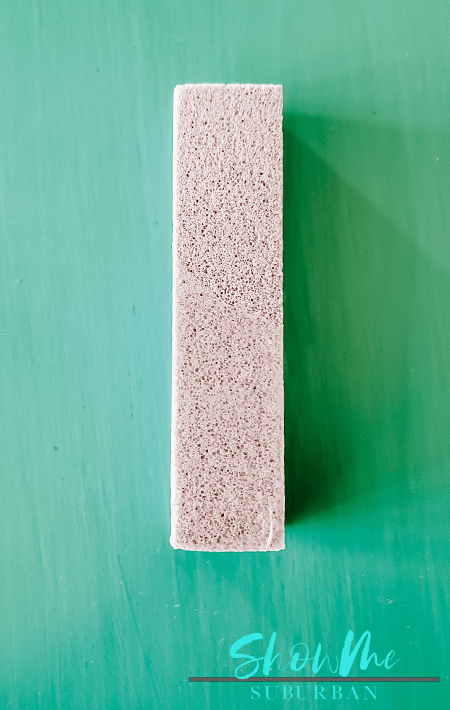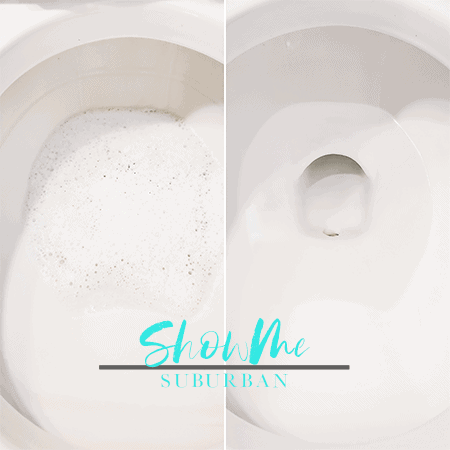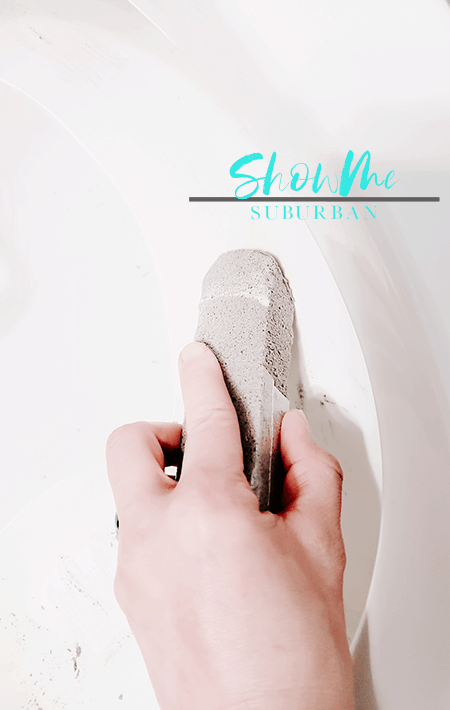This post may contain affiliate links. This means that if you click and make a purchase, I receive a small commission at no additional cost to you. I only recommend products I use and love, or that I would recommend to my mom or best friend. Please see the disclosure statement for additional information.
Stubborn mineral stains on your toilet? Here’s how to easily remove calcium, limescale, and other hard water stains from your toilet bowl..
The local water company must have liked my toilet, because they put a ring on it. They put a ring on every one of my toilets, in fact!
When I got married and moved to my husband’s house, I was surprised to find that those toilet rings I’d been dying to clean would NOT come off. I tried so many products that promised to remove those rings, but they seemed about as permanent as Saturn’s rings. An awesome solution finally emerged, and I was floored with the results.
What causes stain rings inside toilet bowls?
Toilet bowl rings can be caused by a number of different substances – mold, mildew, and rust, to name a few. The kind of ring we’re getting rid of today is caused by mineral deposits. This sort of ring is usually a grayish color, doesn’t come off with regular cleaning/brush scrubbing, and is adhered to the toilet bowl.
Mineral deposits are created when hard water evaporates. As the surface water dries, it leaves tiny deposits of minerals, like calcium and magnesium, around the inside of the toilet bowl. These tiny deposits build up over time to form a gross-looking, seemingly-indestructible ring of hard water stains around the inside of your toilet.
Why don’t normal toilet cleaners work on hard water stains?
Let’s get nerdy, everyone! When it comes to cleaning, there are (basically) 2 options: Physical abrasives and chemical abrasives. Chemical abrasives break a substance down on a molecular level, while physical abrasives use mechanical forces like friction and impact to alter a surface (read more on that here ). Think of it as dissolving the gunk on the bottom of a pan by filling it with soap and water, versus scraping the bottom of the pan with a sponge.
Everyday toilet bowl cleaners work great on, you know, everyday toilet bowl stains. They generally aren’t designed to chemically decompose hard water stains. If the calcium and other minerals have been building up in the toilet for a long time, your normal toilet cleaner won’t stand a chance against that sturdy toilet ring.
What’s the best way to clean a hard water toilet ring stain?
The best toilet bowl cleaner for hard water stains, in my opinion, is a pumice stone.
Before you reach for that pumice stone you use on your feet, STOP. Not all pumice stones are created equally. Some pumice stones are too hard and may damage the finish on your toilet. The best pumice stones for hard water stains are fairly soft and break down somewhat easily. The one I linked to above (also pictured below) is what I use in my home.

That particular pumice stone is great for a few reasons:
- It’s relatively soft so it won’t damage the toilet
- It’s sturdy enough for scrubbing
- It’s fairly long
As a result, you’ll be able to scrub away at the hard water stain without constantly dipping your hand or glove in toilet water. The pumice stone will also absorb water, so a longer one will help keep your hand from becoming wet and slippery.
Here’s a before and after of the most-used toilet in our house, which I scrubbed with a pumice stone (excuse the bubbles in the before photo, I had cleaned the toilet before I started scrubbing):

How do you clean a hard water toilet stain with a pumice stone?
Cleaning mineral deposit rings on the toilet bowl is pretty easy. Here are the steps:
- Clean the toilet as you normally would. This eliminates extra gunk and allows you to focus on the hard water stain.
- (Optional) Turn off the water supply on the toilet, then flush. This will drop the water slightly below the hard water ring line, making it a bit easier to see and clean the stain.
- Put on gloves if desired. Holding the pumice stone at an angle, scrub back and forth along the hard water stain. This will take a little time and effort, but it’s so worth it. The pumice stone will slowly disintegrate as you scrub, so don’t be alarmed.
- Turn the water supply back on (if applicable) and flush the toilet to remove debris.
It’s that simple! I did this on all the toilets in our house, and the difference was completely amazing. After trying so many cleaners on these hard water mineral deposit stains, it was awesome to find that a pumice stone easily did the trick.

The pumice stones I use (linked above) come individually wrapped. I like to leave the the wrapper on the lower half of the pumice stone. Doing so makes the pumice stone more comfortable to hold, and keeps it from becoming wet and slippery in my hand when it starts to absorb water. If you look closely in the photo above, you can see the plastic on the lower half of the pumice stone.
How do you prevent hard water toilet ring stains?
Once you’ve scrubbed the hard water stains off of the toilet bowl, it only takes a little maintenance to prevent them in the future. Remember, those stubborn mineral stains originally built up over a period of time, so they won’t come back overnight.
Clean toilets weekly with your normal toilet cleaner, and quickly scrub along the water line on the inside of the toilet bowl 1-2 times each month. As a result, you’ll ward off the return of the stubborn, unsightly hard water toilet stain.
Can I use a pumice stone to remove hard water stains on other surfaces?
Pumice stones work great on the hard porcelain enamel that covers your toilet. However, they don’t work as well to safely remove hard water stains on other surfaces in your home.
Because pumice stones are a physical abrasive, they can cause significant damage to finished metals, natural and synthetic surfaces (granite, marble, quartz, wood some laminates, etc), and glass. I tried cleaning the hard water stains from our shower doors with the pumice stone, and immediately realized that it scratched the glass! That was a “hard stop” situation.
As with any cleaning product, always test first in an inconspicuous area of the surface you’ll be cleaning. Overall, think of the pumice stone as a very specific solution for a very specific and stubborn problem.
How to get rid of hard water stains on toilet bowls: Conclusion
Hard water stains inside the toilet look terrible, and they are tough to clean with normal cleaners. You can scrub them away with a softish pumice stone to get the toilet to a baseline clean. Going forward, clean toilets weekly with your favorite cleaner, and do a quick pumice stone scrub at the water line 1-2 times per month. The hard water stains will be banished for good, and your toilets will be sitting pretty.
Want even more helpful cleaning and organizing tips for working women? Join the ShowMe Suburban community and learn simple habits and routines to keep your home clean and organized, so you can relax away from work without feeling the stress of a messy home. Sign up below!
